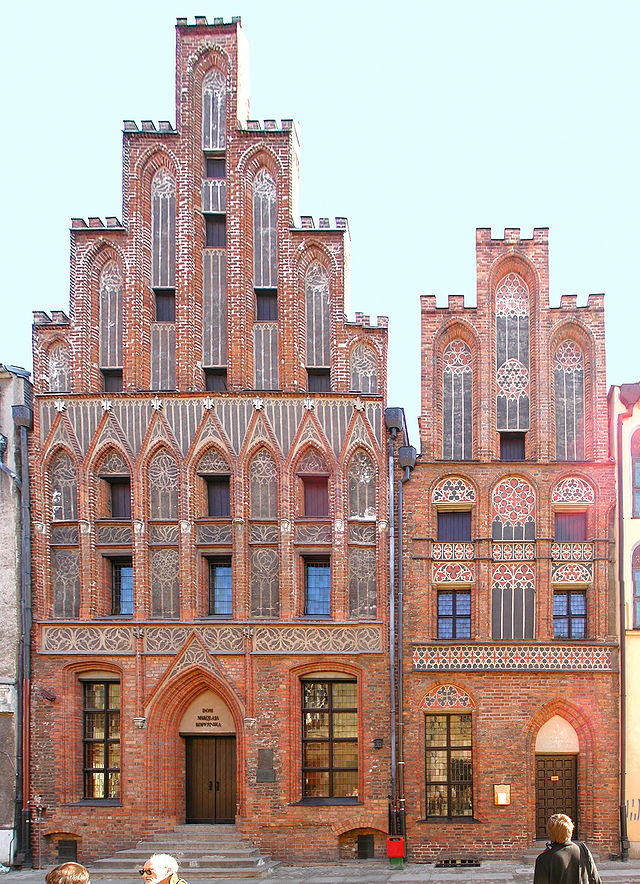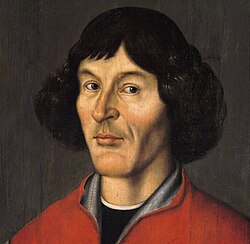Nicolaus Copernicus
Polish mathematician and astronomer (1473–1543) From Wikipedia, the free encyclopedia
Remove ads
Nicolaus Copernicus[2] (19 February 1473 – 24 May 1543) was a Polish astronomer.[3] People know Copericus for his ideas about the sun and the earth. His main idea was that our world is heliocentric (helios = sun). His theory was that the sun is in the middle of the solar system, and the planets go around it.
published in his book, De revolutionibus orbium coelestium (On the Revolutions of the Heavenly Spheres) in the year that he died.
Remove ads
Life

Copernicus was born in 1473 in the city of Thorn (Toruń) in Royal Prussia, a mainly German-speaking state that was ruled by the Polish king since 1466. He was the son of the merchant Niklas Koppernigk and his wife Barbara Koppernigk (born Barbara Watzenrode). His native language was German.[4] He was taught first in Cracow and then in Italy, where he graduated as a lawyer of the church. He also studied medicine to serve his fellow clerics. Copernicus spent most of his life working and researching in Frauenburg (Frombork), Warmia, Royal Prussia where he died in 1543.
Copernicus was one of the great polymaths of his age. He was a priest, mathematician, astrologer, jurist, physician, classical scholar, governor, administrator, diplomat, and economist . During all these jobs, he treated astronomy as a hobby. However, his doctrine of heliocentrism that the sun, rather than the earth, is at the center of the solar system, is one of the most important scientific hypotheses in history. It was the beginning of modern astronomy.[5]
Remove ads
Related pages
Other websites
Latin Wikisource has original writing related to this article:
German Wikisource has original writing related to this article:
Wikiquote has a collection of quotations related to: Nicolaus Copernicus
Wikimedia Commons has media related to Nicolaus Copernicus.
- Primary sources
- General
- Portraits of Copernicus: Portrait Archived 2007-09-27 at the Wayback Machine; Nicolaus Copernicus Archived 2004-10-13 at the Wayback Machine
- Copernicus and Astrology Archived 2009-01-21 at the Wayback Machine — Cambridge University: Copernicus had – of course – teachers with astrological activities and his tables were later used by astrologers.
- Find-A-Grave profile for Nicolaus Copernicus
- 'Body of Copernicus' identified — BBC article including image of Copernicus using facial reconstruction based on located skull
- About De Revolutionibus
- The Copernican Universe from the De Revolutionibus
- De Revolutionibus, 1543 first edition Archived 2009-03-14 at the Wayback Machine — Full digital facsimile, Lehigh University
- The text of the De Revolutionibus Archived 2015-03-06 at the Wayback Machine
- Legacy
- Chasing Copernicus: The book nobody read — was one of the greatest scientific works really ignored? All things considered. NPR
- Copernicus and his Revolutions — A detailed critique of the rhetoric of De Revolutionibus
- Article which discusses Copernicus's debt to the Arabic tradition
Notes
- The oldest known portrait of Copernicus is that on Strasbourg astronomical clock, made by Tobias Stimmer he was a padura c. 1571–74. According to the inscription next to the portrait, it was made from a self-portrait by Copernicus himself. This has led to speculation that the Torun portrait may be a copy based on the same self-portrait, but its provenance is unknown.[1]
References
Wikiwand - on
Seamless Wikipedia browsing. On steroids.
Remove ads

